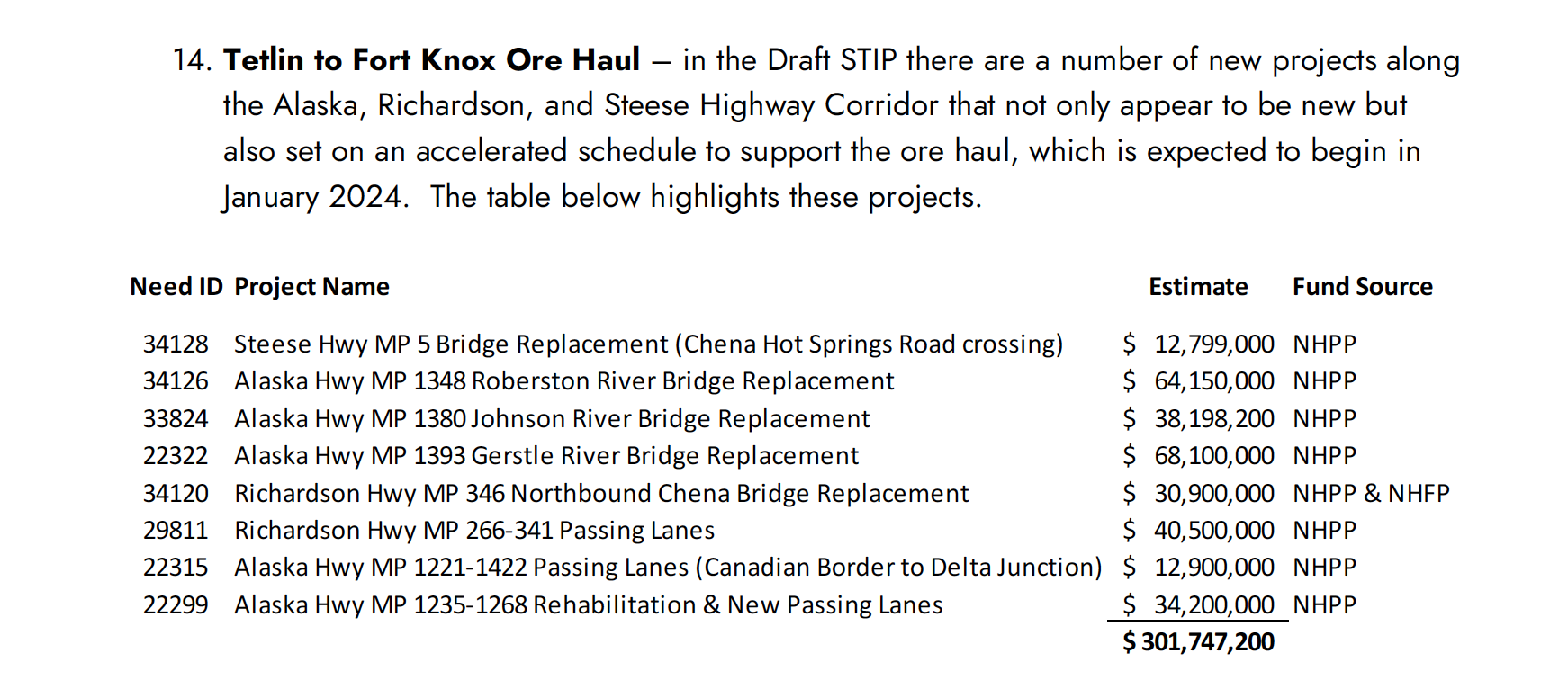Before moving on $300 million in road projects, state should hear from committee studying ore haul trucking
The State Transportation Improvement Plan, known throughout the bureaucratic realm as the STIP, is not supposed to be a top-down affair. Federal law requires that the state work with local planning organizations in deciding what transportation projects to build and when.
“The STIP provides a transparent and accountable process for allocating resources and managing transportation projects,” the Department of Transportation and Public Facilitiies proclaims on its website.
But the version of the plan now out for public comment “appears to have been developed internally without meaningful input from stakeholders throughout the state,” according to a draft letter from Jackson Fox, executive director of of the Fairbanks Area Surface Transportation planning agency.
The Anchorage planning group says there as “no coordination” with its municipal office and “it is hard to see why some projects are being funded over others.”
In other words, it was a top-down exercise.
One conclusion to be drawn is that the Dunleavy administration took steps to short-circuit the normal planning process to advance projects that it believes will help the Kinross Manh Choh mine in Tetlin and the ore-hauling operation to the Fort Knox mine.
DOTPF Commissioner Ryan Anderson directed that four bridge projects be added to the STIP last December, two of which are within the Fairbanks area, the northbound lanes of the Richardson at the flood control project and the Steese Highway bridge over Chena Hot Springs Road.
“His direction was to get these initiated and moving as quickly as possible so that is the plan,” wrote engineer Sarah Schacher, a former state transportation planner, after a mid-December meeting with Anderson.
The draft letter from the Fairbanks transportation planners says the state added $300 million in projects to support the Kinross ore-hauling plan, but has not consulted with the state Transportation Advisory Committee set up by the Dunleavy administration to analyze the potential impacts of the trucking plan on road safety and infrastructure.
The $300 million estimate of the cost is probably far too conservative, given the big jump in construction costs. Plus, the projects have not been designed, so these numbers are guesses at this point.
The advisory committee’s recommendations are yet to be written, but the state is moving ahead with road projects that may differ from the committee’s future recommendations. When the recommendations are finished, they may reflect different priorities.
The FAST letter said that on July 26 the corridor advisory committee discussed bus stop safety along the 240-mile trucking route, but that is not addressed in the state transportation plan. Added road maintenance costs from the Kinross operations are not addressed. Neither is the report that three of the five bridges proposed to be replaced have an estimated 25 years of life left, even with the ore haul plan.
I believe the Dunleavy administration created the Transportation Advisory Committee as an attempt to silence and distract critics, not to conduct a full examination of the implications of the ore-hauling project. The committee is moving forward, however, and has brought issues into the light that the state has ignored. Its work is due to be finished this fall.
The state has acted all along like a corporate partner with Kinross. Dunleavy has given clear signals that he wants the state to assist Kinross as much as possible. The state is a corporate partner of sorts with Contango, the company that owns 30 percent of the Tetlin joint venture, having invested $10 million in Contango through the Alaska Permanent Fund.
Part of the oversight work the Dunleavy administration should be doing is being undertaken by a citizens’ group, Advocates for Safe Alaska Highways, which continues to raise questions that the governor and his underlings want to suppress. Its members have contributed to the work of the advisory committee.
The Tetlin mine would operate for 4.5 years, but promoters have made it clear they want to look for other reserves to keep the trucks going for the long term.
To demonstrate that the work of the Transportation Advisory Committee is more than a bureaucratic placebo, the Dunleavy administration should wait to see what the committee comes up with before deciding on projects that are likely to cost well more than $300 million to support the mining operation.
Your contributions help support independent analysis and political commentary by Alaska reporter and author Dermot Cole. Thank you for reading and for your support. Either click here to use PayPal or send checks to: Dermot Cole, Box 10673, Fairbanks, AK 99710-0673.

